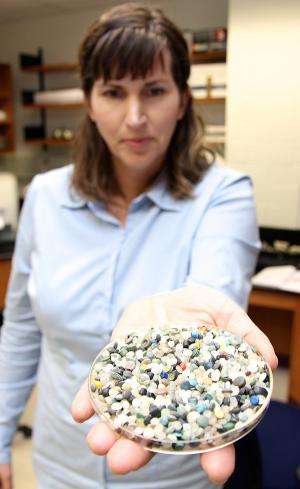Polyethylene and polypropylene beads threaten shoreline ecosystems

You likely wouldn't spot them, unless digging through the sand on your hands and knees, but a miniature plastic pest along the shoreline of the Great Lakes could result in huge headaches for the environment and, even, humans.
Western Earth Sciences professor Patricia Corcoran says while plastic trash such as bottles, cups and other materials may be easily visible, when they're the size of a lentil it quickly becomes an invisible menace.
"If you don't get down and look, you may still notice there is organic material and there is a strandline where you will find bigger pieces. When you get on your hands and knees and start digging through the organic materials, you can find thousands of them (pellets)," Corcoran said.
So, what are these plastic pellets and where do they come from?
The polyethylene and polypropylene pieces are used to make a wide variety of plastic products. There are companies producing the raw product and others using the raw products to melt down – a large number of these companies are in the Sarnia area.
"There are multiple ways in which they can spill," Corcoran said. "One, they spill from railcars. When they are taking the hose off to unload, they are so light that some will inevitably fall out. And as soon as it rains, they wash down to the storm sewers and out to the lakes."
At the companies themselves, she added, the pellets are being washed down the drains and also ending up in the water.
"No matter what kind of plastic it is, unless it is buried in the landfill, it will always end up in the water. It can blow with the wind and be transferred by water so easily," she said.
Corcoran, along with her graduate and undergraduate students, has done previous studies of the pesky pellets along the shores of lakes Huron, Erie and St. Clair. Most recently, they scoured the shores of Humber Bay in Lake Ontario, near Toronto.
The aim was to sample along the entire shoreline of Lake Ontario, but it didn't take much to find a treasure trove of pellets.
"In an area of just 25 square metres, we collected over 3,000 pellets – and that's just from five centemetres below the surface. We did not dig very far," said Corcoran, adding they picked out each pellet by hand. "I expected there to be plastic, but I was shocked there was that much, and we were there for just four hours."
Thousands upon thousands more of these pellets remain unaccounted for, and they are wreaking havoc in the lakes – killing sea birds, fish and having the possibly to harm the general public.
"There are sea birds that have been found with an abundance of plastic in their guts," Corcoran said. "As there are no nutrients in the plastic, they feel full and don't go out to look for food. So, they starve to death with their stomach full. It's really sad.
"And with the fish who ingest it, because they're filter feeders and not selective in what they're taking in from the water, it ends up getting stuck in their digestive tract. They can't excrete it, and end up dying."
The plastic pellets can also absorb pollutants from the water and, if a fish were to eat the pellets, it is possible those pollutants could be absorbed into their system. If we then eat those fish, it is possible it could travel up the food chain.
A University of Wisconsin colleague has started looking at fish from the Great Lakes and has found fibres in the stomachs of those in lakes Erie and Superior.
An additional problem with the floating plastic debris is organisms tend to encrust the plastic debris and, because it can move hundreds of kilometres by floating, it can transport different species into other areas.
Adding even more anxiety, there are higher-density plastics that sink, such as polyvinyl chloride, which may already be carpeting the floor of the Great Lakes.
"This has been shown to be the case in marine settings, where there is an abundance of plastic at depth, but we don't know if that's the case for the Great Lakes," Corcoran said.
Part of her project is working with the Ministry of the Environment and Environment Canada to take sediment core samples from the lake bottom to see how much plastic is down there.
"We're not sure to what degree they will be broken down; we have no idea," Corcoran said. "We're trying to find out just how much plastic is out there. Is there enough to cause alarm? It's not only what you see, but also what's below the surface, which could affect the temperature of the lake bottom, affect the movement of nutrients and the nutrient cycle. So, the organisms that are living down there, if there is too much plastic, it's going to change the whole ecosystem."
While there is a global initiative called Operation Clean Sweep, specifically around the awareness of the plastic pellet problem that encourages companies to control the amount of spillage, it is completely voluntary.
"Whether or not they follow it is up to them," said Corcoran, who wouldn't mind seeing public policy around this issue come from her research. "The problem we face is changing industries point of view because, let's face it, they need to sell their plastic – and we still need plastic – but but there also needs to be better care taken."
Provided by University of Western Ontario
















